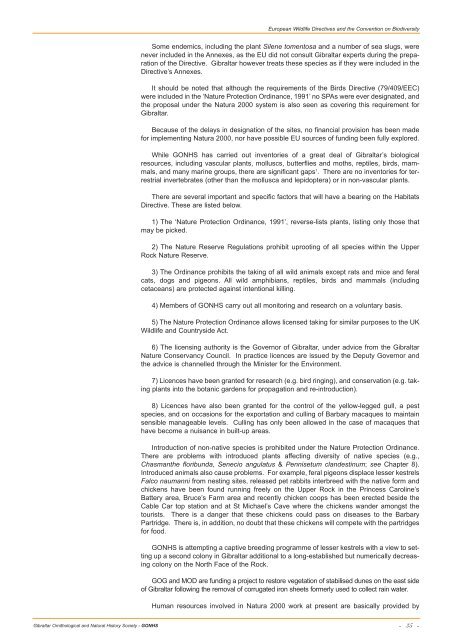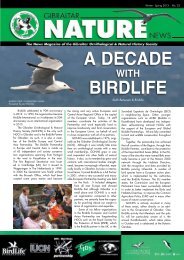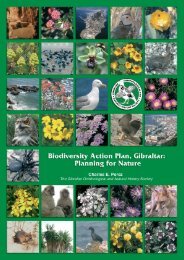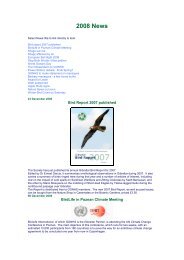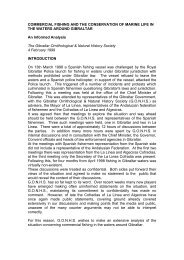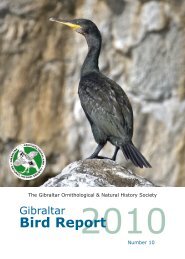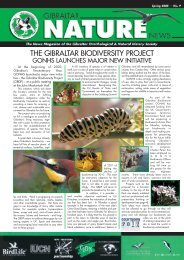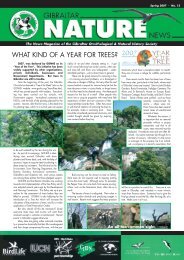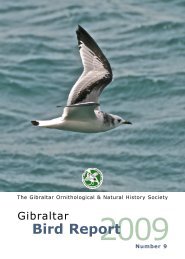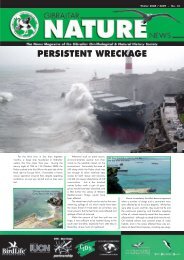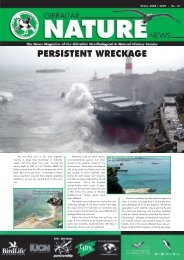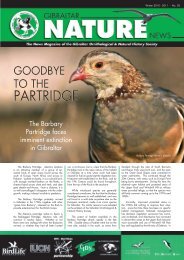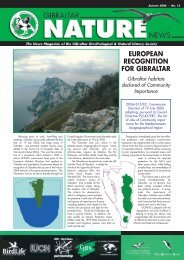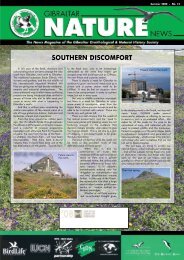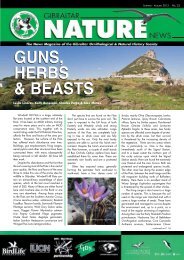Upper Rock Nature Reserve: A Management and Action Plan
Upper Rock Nature Reserve: A Management and Action Plan
Upper Rock Nature Reserve: A Management and Action Plan
Create successful ePaper yourself
Turn your PDF publications into a flip-book with our unique Google optimized e-Paper software.
Gibraltar Ornithological <strong>and</strong> Natural History Society - GONHS<br />
European Wildlife Directives <strong>and</strong> the Convention on Biodiversity<br />
Some endemics, including the plant Silene tomentosa <strong>and</strong> a number of sea slugs, were<br />
never included in the Annexes, as the EU did not consult Gibraltar experts during the preparation<br />
of the Directive. Gibraltar however treats these species as if they were included in the<br />
Directive’s Annexes.<br />
It should be noted that although the requirements of the Birds Directive (79/409/EEC)<br />
were included in the ‘<strong>Nature</strong> Protection Ordinance, 1991’ no SPAs were ever designated, <strong>and</strong><br />
the proposal under the Natura 2000 system is also seen as covering this requirement for<br />
Gibraltar.<br />
Because of the delays in designation of the sites, no financial provision has been made<br />
for implementing Natura 2000, nor have possible EU sources of funding been fully explored.<br />
While GONHS has carried out inventories of a great deal of Gibraltar’s biological<br />
resources, including vascular plants, molluscs, butterflies <strong>and</strong> moths, reptiles, birds, mammals,<br />
<strong>and</strong> many marine groups, there are significant gaps 1 . There are no inventories for terrestrial<br />
invertebrates (other than the mollusca <strong>and</strong> lepidoptera) or in non-vascular plants.<br />
There are several important <strong>and</strong> specific factors that will have a bearing on the Habitats<br />
Directive. These are listed below.<br />
1) The ‘<strong>Nature</strong> Protection Ordinance, 1991’, reverse-lists plants, listing only those that<br />
may be picked.<br />
2) The <strong>Nature</strong> <strong>Reserve</strong> Regulations prohibit uprooting of all species within the <strong>Upper</strong><br />
<strong>Rock</strong> <strong>Nature</strong> <strong>Reserve</strong>.<br />
3) The Ordinance prohibits the taking of all wild animals except rats <strong>and</strong> mice <strong>and</strong> feral<br />
cats, dogs <strong>and</strong> pigeons. All wild amphibians, reptiles, birds <strong>and</strong> mammals (including<br />
cetaceans) are protected against intentional killing.<br />
4) Members of GONHS carry out all monitoring <strong>and</strong> research on a voluntary basis.<br />
5) The <strong>Nature</strong> Protection Ordinance allows licensed taking for similar purposes to the UK<br />
Wildlife <strong>and</strong> Countryside Act.<br />
6) The licensing authority is the Governor of Gibraltar, under advice from the Gibraltar<br />
<strong>Nature</strong> Conservancy Council. In practice licences are issued by the Deputy Governor <strong>and</strong><br />
the advice is channelled through the Minister for the Environment.<br />
7) Licences have been granted for research (e.g. bird ringing), <strong>and</strong> conservation (e.g. taking<br />
plants into the botanic gardens for propagation <strong>and</strong> re-introduction).<br />
8) Licences have also been granted for the control of the yellow-legged gull, a pest<br />
species, <strong>and</strong> on occasions for the exportation <strong>and</strong> culling of Barbary macaques to maintain<br />
sensible manageable levels. Culling has only been allowed in the case of macaques that<br />
have become a nuisance in built-up areas.<br />
Introduction of non-native species is prohibited under the <strong>Nature</strong> Protection Ordinance.<br />
There are problems with introduced plants affecting diversity of native species (e.g.,<br />
Chasmanthe floribunda, Senecio angulatus & Pennisetum cl<strong>and</strong>estinum; see Chapter 8).<br />
Introduced animals also cause problems. For example, feral pigeons displace lesser kestrels<br />
Falco naumanni from nesting sites, released pet rabbits interbreed with the native form <strong>and</strong><br />
chickens have been found running freely on the <strong>Upper</strong> <strong>Rock</strong> in the Princess Caroline’s<br />
Battery area, Bruce’s Farm area <strong>and</strong> recently chicken coops has been erected beside the<br />
Cable Car top station <strong>and</strong> at St Michael’s Cave where the chickens w<strong>and</strong>er amongst the<br />
tourists. There is a danger that these chickens could pass on diseases to the Barbary<br />
Partridge. There is, in addition, no doubt that these chickens will compete with the partridges<br />
for food.<br />
GONHS is attempting a captive breeding programme of lesser kestrels with a view to setting<br />
up a second colony in Gibraltar additional to a long-established but numerically decreasing<br />
colony on the North Face of the <strong>Rock</strong>.<br />
GOG <strong>and</strong> MOD are funding a project to restore vegetation of stabilised dunes on the east side<br />
of Gibraltar following the removal of corrugated iron sheets formerly used to collect rain water.<br />
Human resources involved in Natura 2000 work at present are basically provided by<br />
- 35 -


